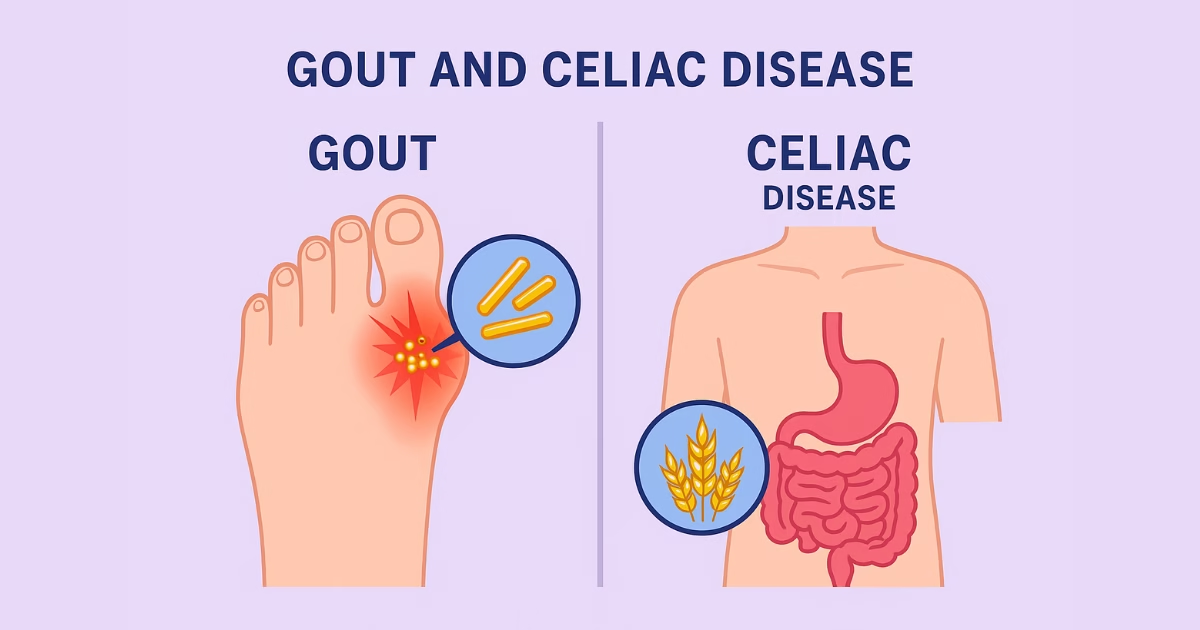Gout and celiac disease are two health problems that may seem unrelated, but some people struggle with both. Gout is a type of arthritis that causes sudden pain, often in the big toe. Celiac disease is an autoimmune condition that reacts badly to gluten, a protein found in wheat, barley, and rye. While they affect the body in different ways, both involve inflammation. That’s why many wonder if there’s a link between gout and celiac disease. Can gluten make gout worse? Could one condition trigger the other? This blog explores the connection, symptoms, diet tips, and how to manage both together. It’s important to understand these issues if you’re dealing with either one—or both. The right knowledge can help reduce pain, improve your lifestyle, and avoid serious complications. Let’s break it down step by step.
What Is Gout and Celiac Disease?
Gout is a painful form of arthritis caused by too much uric acid in the blood. When the body can’t remove this acid properly, sharp crystals can form in the joints. This leads to swelling, redness, and intense pain. Gout often affects the big toe, but it can show up in other joints too.
Celiac disease, on the other hand, is an autoimmune disorder. When someone with celiac eats gluten, their immune system attacks the small intestine. Over time, this damages the gut lining and makes it hard to absorb nutrients. People with celiac disease may suffer from stomach pain, diarrhea, fatigue, and even skin rashes.
Both gout and celiac disease are serious conditions. They may not seem connected at first, but both involve the immune system and inflammation. That’s why researchers are now looking into how they might be linked.
Possible Connection Between Gout and Celiac Disease
At first glance, gout and celiac disease look like two very different health issues. Gout is mostly about uric acid levels, while celiac disease is a reaction to gluten. But inflammation ties them together. Both conditions cause the immune system to overreact in some way.
Some researchers believe there might be a connection. In people with untreated celiac disease, the gut doesn’t absorb nutrients well. This poor absorption can affect kidney function, which helps remove uric acid. If kidneys don’t work right, uric acid can build up in the blood—leading to gout attacks.
Also, both diseases can cause joint pain. This makes it hard for doctors to tell them apart sometimes. A person with joint pain might think they have gout, when it could be related to celiac disease—or even both at the same time.
Still, studies on this connection are limited. More research is needed. But doctors are starting to look closer at how these two issues may work together in the body.
Can Gluten Affect Gout Symptoms?
This question comes up often. If gluten causes trouble in celiac disease, could it also make gout worse? There’s no clear answer yet, but some clues suggest it might.
For people with both gout and celiac disease, gluten may trigger inflammation that worsens gout flares. Inflammation plays a big role in both conditions. Even in people without celiac, gluten might cause mild inflammation—especially if they are sensitive to it.
Also, eating gluten-heavy foods like white bread, pasta, and baked goods may lead to weight gain. Extra weight is a known risk factor for gout. So while gluten itself might not directly raise uric acid, the foods that contain it could increase gout risk indirectly.
Some people say they feel better when they remove gluten from their diet. Less pain. Fewer flares. But these are personal stories, not proof. Still, trying a gluten-free diet under a doctor’s guidance might help some people manage their symptoms better.
Shared Symptoms and Confusing Signs
Celiac disease and gout share a few symptoms, which can confuse people. The biggest one is joint pain. In gout, this pain usually hits fast and hard. A red, swollen toe is a classic sign. But celiac disease can also cause long-term joint discomfort. It’s duller, not as sharp, but still annoying.
Fatigue is another one. Gout flares can leave someone feeling drained. Celiac disease causes fatigue too, mostly because the body can’t take in enough nutrients. That tired feeling can stick around even after a meal.
Swelling and inflammation are also common in both. This makes it tricky for doctors. They have to dig deeper—look at test results, food habits, and medical history—to figure out what’s really going on.
That’s why it’s so important not to self-diagnose. A sore knee might be from gout. Or it could be from celiac-related joint inflammation. Only proper testing can show the truth.
Gluten-Free Diet and Gout: Pros and Cons
Many people switch to a gluten-free diet to treat celiac disease. But what if you have gout too? Is it still a good idea?
The answer is… it depends.
On the plus side, going gluten-free can reduce inflammation. That’s great for people with both gout and celiac disease. A cleaner diet full of fruits, vegetables, lean proteins, and whole grains like quinoa may help lower uric acid and support gut health.
But not all gluten-free foods are healthy. Many store-bought gluten-free snacks are full of sugar and unhealthy fats. These can actually make gout worse. Also, some gluten-free substitutes are low in fiber and high in calories, leading to weight gain—a risk factor for gout.
So a gluten-free diet helps, but only if done right. Whole foods, plenty of water, and balance are key. And it’s always smart to work with a nutritionist or doctor to make sure you’re doing what’s best for your body.
Managing Gout and Celiac Disease Together
Dealing with both gout and celiac disease at once isn’t easy, but it’s possible with the right steps. The key is to control inflammation, avoid triggers, and support overall health.
First, diet is crucial. Stay away from gluten—no wheat, barley, or rye. Read food labels carefully. At the same time, limit foods high in purines, like red meat, organ meat, and seafood, which can raise uric acid levels. Also avoid sugary drinks and too much alcohol.
Focus on foods that fight inflammation. Leafy greens, berries, low-fat dairy, and whole gluten-free grains like brown rice are good options. Drink lots of water. It helps flush out uric acid.
Exercise helps too. Staying active can reduce weight, ease joint pressure, and boost mood. Just make sure to avoid workouts that put too much stress on painful joints.
Lastly, take medications as prescribed. Whether it’s for gout or celiac, staying on top of treatment is key to feeling better long-term.
Medical Advice and When to See a Doctor
If you have symptoms of either gout or celiac disease—or both—it’s time to speak to a doctor. Don’t wait. Self-treatment can lead to bigger problems down the road.
Doctors usually check for gout with a blood test to see uric acid levels. Sometimes they’ll test joint fluid too. For celiac disease, a blood test checks for certain antibodies. A biopsy of the small intestine may confirm the diagnosis.
You may also need help from specialists. A rheumatologist treats gout, while a gastroenterologist focuses on celiac disease. Working with both can give you the best results.
Also, keep a food diary. It helps track what foods trigger symptoms. Bring it to your doctor visits. It’s a small thing, but it can offer big clues.
Getting the right diagnosis is half the battle. Once you know what’s going on, managing it becomes a lot easier.
Myths and Misconceptions
There are many myths about gout and celiac disease. Let’s clear a few up.
Myth 1: Gluten causes gout.
Not exactly. Gluten doesn’t cause gout directly, but it might make things worse in people who already have it—especially those with celiac disease.
Myth 2: Only meat causes gout.
Wrong. While red meat and organ meats are high in purines, sugary drinks and alcohol are also big triggers. It’s not just about meat.
Myth 3: Gluten-free food is always healthy.
False. Many processed gluten-free foods are full of sugar and fat. They might be bad for gout, even if they’re okay for celiac.
Myth 4: Joint pain always means gout.
Not true. Celiac disease can cause joint pain too. So can other conditions. That’s why proper testing is so important.
Final Thoughts
Living with gout and celiac disease at the same time isn’t simple. But with the right care, it can be done. Both conditions are serious and need attention. They share some symptoms, and both involve inflammation. That makes their connection worth exploring.
Understanding your body, watching your diet, and getting medical advice are key steps. You don’t need to guess. With help from doctors, a healthy lifestyle, and smart food choices, you can take control of both conditions.
There’s still more research to do about the link between gout and celiac disease. But what we know already shows how important it is to pay attention. Managing one condition may help improve the other.
The bottom line? Knowledge is power. The more you know about gout and celiac disease, the better you can fight back and live well.

Hi, I’m Shafy Ali – a curious mind and passionate writer at Celiac Magazine. I cover a little bit of everything, from everyday tips and how-tos to deeper dives into topics that spark conversation. I enjoy turning research into readable, relatable content that informs and inspires. Whatever the subject, I aim to keep it clear, engaging, and genuinely useful.

